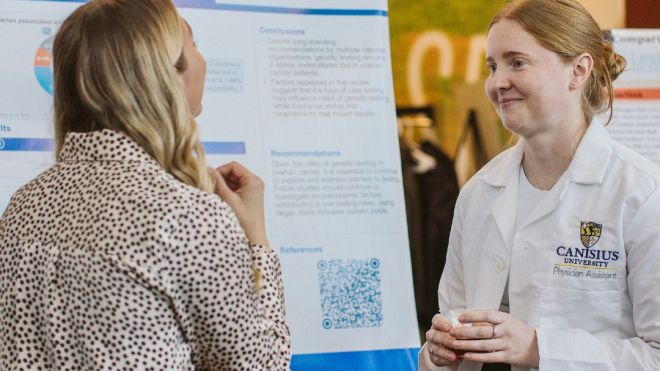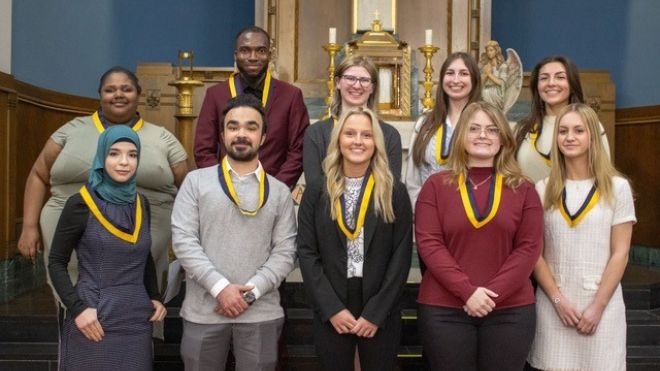
It may be winter in Western New York but the city of Buffalo is in full bloom.
Tangible signs of development are apparent in every direction: To the north, the Buffalo Niagara Medical Campus (BNMC) is erupting into an expansive and vital high-tech health corridor. To the south, a four-seasons’ destination is beckoning visitors from far and wide to the HARBORCENTER hockey and entertainment complex and its Canalside companion. In between and all along the outskirts, the groundwork is being laid for innovative job-generating industries and the robust rise of a truly metropolitan housing market.
Add a world-class educational institution like Canisius to the mix, and the depth and breadth of opportunities for college students becomes unlimited.
“Buffalo’s rebirth is providing young adults with a renewed opportunity to learn, to launch a career and to build a life in this region,” says Kathleen B. Davis, vice president for enrollment management at Canisius.
In fact, the American Institute for Economic Research (AIER) ranks Buffalo number 12 (amongst mid-size metros) on its most recent list of Best U.S. Cities for College Students. The ranking takes into account the area’s cost of living, earning potential for residents, diversity and city accessibility. It also considers Buffalo’s entrepreneurial activity, its capacity for academic research and development, the percent of the population with college degrees, and the concentration of arts, entertainment and recreation venues.
Now you’re probably wondering what all this means for high school students (and their parents) amidst the college search process. The answer? Plenty!
“A college’s physical location matters more than ever before in the ultimate success of graduates,” Davis says.
Juston Lee Locklear ’17 concurs.
“When I started looking at colleges, I knew I wanted to be in a city where I would not get lost in the shuffle,” says Locklear, from St. Pauls, N.C. “I wanted a place that offered a variety of big city experiences and opportunities but had a small-town feel.”
In fact, the value of higher education, Davis continues, “is increasingly tied to practical learning and living experiences available off campus.” Think internships, research opportunities, volunteer and service work. “These experiences are plentiful for students who go to school in regions that are growing and have diverse economies.”
And that’s exactly where Buffalo is headed.
Back in Business
The Rust Belt roots of what was once an industrial hub are now replaced by innovative enterprises in advanced manufacturing, business services, life sciences and high-tech trades. All these new industries – and others – are rapidly reshaping and reviving Buffalo’s economy.
In recent years, SolarCity began construction on what promises to be the largest solar panel factory in the Western Hemisphere. When opened in the next year, the full-service solar power provider is expected to create upwards of 1,500 jobs in the region.
The Buffalo Niagara Medical Campus broke ground on a 2 million square foot clinical, research and development complex, which is expected to bring an additional 5,000 jobs downtown over the next couple years. The consortium of world-class hospitals, healthcare facilities and research institutions already employs 12,000.
IBM announced the addition of 500 new information technology jobs to its Buffalo workforce. Employees will develop next-generation software for molecular research, genomics, energy efficiency development and defense.
But that’s not all.
Buffalo is working overtime to bring even more innovative business ventures to town. Local efforts include 43North, a business plan competition that awards up to $5 million in prizes to winning companies that relocate here.
Start-Up NY is a statewide initiative that provides tax exemptions to new and expanding businesses when they locate on or near college campuses. The idea is to spur economic development while providing joint research opportunities for college faculty and practical learning experiences for students. In Buffalo, more than 40 companies and 11 higher education institutions participate in Start-Up NY. Canisius University is proud to be among them.
And if all this wasn’t enough: “It used to be that people moved to where the businesses were,” says George Palumbo, PhD, professor of economics and director of Canisius’ one-year MBA program. “Increasingly, businesses look to expand or move to locations where there is an abundance of talent, especially young, college-educated talent.”
The Young and the Educated
It’s easy then to understand Buffalo’s appeal.
The region is home to 22 higher education institutions, which enroll a combined 112,000 students and graduate 28,000 annually. Buffalo employers eagerly take advantage of this broad talent pool, most often via internship programs.
“Our internship program really helps Citi determine which students are the best fit and then our summer experience helps groom them for potential employment,” says Judy Bassanello ’83, vice president for product control at Citi.
She notes that in the past five years, the global bank has recruited nearly 200 Canisius students with majors in business, finance and economics. That number is expected to increase, as Citi grows its Buffalo operations.
“Citi utilizes its strong ties with Canisius to create a pipeline of well-educated, business-ready students who can fill important rolls in our local offices,” Bassanello adds.
Of course, there’s an added benefit when new and growing businesses engage a well-educated talent pool.
“Today’s young adults can really infuse an institution with fresh ideas and perspectives,” says Matt Enstice MBA ’04. As president and chief executive officer of the Buffalo Niagara Medical Campus, Enstice leads the organization in its goal of re-energizing the city by leveraging the assets of the Medical Campus institutions to have a significant, positive impact on the surrounding community. To help ensure a dynamic, collaborative and creative exchange of ideas, the BNMC team often calls upon Canisius students to provide additional expertise and support in areas such as business development, transportation and infrastructure planning, healthy community-building, energy, housing, and youth and education.
Such win-win experiences, for students and the city, are plentiful in a region amidst a renewal – no matter the field of study.
Canisius sociology majors foster strong, safe and viable urban neighborhoods by cultivating community gardens. Through the college’s Mentor Resource Lab, biology students teach STEM subjects (science, technology, engineering and math) to elementary students in Buffalo’s underprivileged schools. Management and marketing majors develop business plans for refugees interested in opening ethnic stores and shops in their new hometown.
And students in the Canisius Video Institute produce social and service-oriented documentaries to advance the missions of Buffalo’s nonprofit agencies and promote social, cultural and ethical change and well-being.
“By engaging the region’s best and brightest college students, we’re helping to educate them and simultaneously encouraging them to make a small piece of Buffalo’s revitalization their own,” Enstice adds.
Today’s college students are, in fact, vital to the region’s health – quite literally.
In Need of MDs – STAT
Despite Buffalo’s burgeoning medical and research corridor, the city and its eight surrounding counties currently suffer from the worst doctor shortage in the state. According to the Healthcare Association of New York, the region has an average of only 60 family medicine physicians per 100,000 patients. (The national average is 80 family practitioners per 100,000 patients.) A significant symptom contributing to this diagnosis: the area’s aging population of doctors.
To help remedy this condition, Buffalo’s medical community is partnering with local colleges and universities in a coordinated effort to educate, train and retain the region’s next generation of caregivers.
At Canisius, this partnership takes the form of the Medical Advisory Board (MAB).
“Part of our job is to keep, in town, these highly-qualified students interested in science and medicine by making sure they have access to all of the rich learning resources available in the community,” says Mark J. Lema ’71, MD, PhD, a founding member and chair of the Medical Advisory Board at Canisius.
Comprised of nearly 50 medical professionals, MAB members share their knowledge as guest lecturers in pre-med classes and labs. They assist students with mock medical school interviews. Their principal role, however, is to serve as liaisons between Canisius’ pre-med students and the local medical community.
“They connected me with opportunities that medical schools want applicants to have,” says Korry Wirth ’16. The biochemistry major “shadowed physicians in clinics and in operating rooms, and volunteered at community clinics.” Most recently, he was “investigating how ovarian cancer works,” as a research assistant in the Cancer Genetics Department at Roswell Park Cancer Institute.
Meaningful and mentored experiences are critical to future physicians but financial support also goes a long way in a student’s decision to continue the costly road of medical school. To help ease such worries, the Medical Advisory Board at Canisius and similar physician-led groups are providing scholarship assistance to students, with the goal of keeping these future medical professionals in Western New York after graduation.
“I was so grateful to receive the support I did for medical school,” says Taryn C. Spencer ’12. Spencer grew up in Buffalo. She attended the Buffalo Academy for the Visual and Performing Arts, graduated from Canisius with a degree in biology and is now studying at the University at Buffalo School of Medicine and Biomedical Sciences. “I can’t wait to finish medical school. This is such an amazing time to be in Buffalo and I just want to go out and make a life – and a difference – in my hometown.”
A City Spreading its Wings
This kind of enthusiasm is giving our once-gritty city new wings and attracting a generation of young people to the state’s second largest metropolis.
Despite its overall decrease in population, U.S. census data shows that the number of people in Buffalo between the ages of 25 and 34 jumped 34 percent from 2000 to 2012. That’s more than New York City and Los Angeles experienced during the same period!
“Major new employers in this area are offering good paying jobs and that’s attracting some positive attention,” says Dottie Gallagher-Cohen, president and chief executive officer of the Buffalo Niagara Partnership. “Now these jobs don’t necessarily pay what they would in New York City but the cost of living in Buffalo doesn’t require it so people are able to have a fantastic quality of life here.”
If it’s been a while since you’ve visited, the city still has its professional sports teams, world-class art galleries and array of eclectic shops and restaurants throughout the Elmwood, Delaware, Allentown and Hertel districts. But the revitalization of Buffalo’s waterfront is beckoning the young and the old, like never before.
There’s ice skating at Canalside in the winter; kayaking in the spring and summer. Food Truck Tuesday(s) at Larkin Square is a trendy place to enjoy inexpensive meals and live music. Even the abandoned grain elevators from Buffalo’s bygone industrial era have been brought back to life. They now serve as a canvas for the city’s latest public art project: a year-round, multicolored LED light installation that illuminates the Outer Harbor every night at dusk.
“Buffalo has drastically changed since I left,” says Dan Weinstein MBA ’13. A manager of competitive intelligence with HealthNow New York, Weinstein worked 10 years in Washington, D.C. and Nebraska before moving back to Buffalo’s more family-friendly atmosphere. “I don’t ever remember buildings going up downtown and now I see it every day. There’s just so much to do now.”
In fact, Buffalo is becoming what a true college town should be: a melting pot of young minds mixed with long-standing institutions and traditions. A place where the identity of the city is not just complemented by young, college-educated people but is shaped by them.
“The region is ripe with amazing places, people and neighborhoods,” says Scott Loffler MS ’05, director of lacrosse operations for the Buffalo Bandits. Loffler turned down a job opportunity in Boston, MA to be in Buffalo. “Here, you can walk down the street and find yourself immersed in a different experience and culture on every block. Throw in the museums, architecture, waterfront, shopping districts, festivals and the food (ooh, the food) and it’s easy to see why Buffalo is such a great place to learn, to live and to raise a family.”



